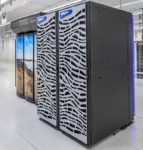Today, Bright Computing announced that Simula Research Laboratory has chosen Bright Cluster Manager to manage its multi-architecture, multi-OS HPC environment. “After a careful evaluation, Simula chose Bright Cluster Manager to provide comprehensive management of eX³, enabling the organization to administer its HPC platform as a single entity; provisioning the hardware, operating systems, and workload managers from a unified interface. Further, the intuitive Bright management console will allow Simula to see and respond to what’s happening in their cluster anywhere, at any time.”
Why HPC is no longer just for government labs and academic institutions
In this special guest feature, Trish Damkroger from Intel writes that only HPC can handle the pending wave of Big Data coming to datacenters from Smart Cities. “While each individual city’s data footprint depends on the unique mix of smart applications deployed, you could guess that each smart city still has a lot of data to contend with. In the future, many cities may turn to AI algorithms to tap into this data to manage city operations. However, the scale of the data and need for rapid insights will make HPC-level computing resources a requirement to make the most of this opportunity.”
GIGABYTE Steps up with a Broad Array of Server Offerings for AI & HPC
In this video from SC19, Peter Hanley from GIGABYTE describes how the company delivers a full range of server solutions for HPC, AI, and the Edge. “GIGABYTE is an industry leader in HPC, delivering systems with the highest GPU density combined with excellent cooling performance, power efficiency and superior networking flexibility. These systems can provide massive parallel computing capabilities to power your next AI breakthrough.”
2nd Generation Intel® Xeon® Scalable Processors Demonstrate Amazing HPC Performance
In this guest article, our friends at Intel discuss how benchmarks show key workloads average 31% better on Intel Xeon Platinum 9282 than AMD EYPC “Rome” 7742. Intel analysis provides strong evidence that the 2nd Generation Intel Xeon Scalable Processor (Cascade Lake “CLX”) architecture provides dramatic performance for real-world workloads. An impressive array of benchmarks shows 2S systems built with Intel’s 56 core processors (Intel Xeon Platinum 9282 processor) solidly ahead of systems built with AMD’s 64 core processors (AMD EYPC 7742).
Optimizing in a Heterogeneous World is (Algorithms x Devices)
In this guest article, our friends at Intel discuss how CPUs prove better for some important Deep Learning. Here’s why, and keep your GPUs handy! Heterogeneous computing ushers in a world where we must consider permutations of algorithms and devices to find the best platform solution. No single device will win all the time, so we need to constantly assess our choices and assumptions.
Reflections on Deep Learning, DNNs, and AI on Wall Street
In this special guest feature, Bob Fletcher from Verne Global reflects on the recent HPC and AI on Wall Street conference. “Almost every organization at the event talked about their use of machine learning and some indicated what would make them extend it into full-scale deep learning. The most important criteria were the appropriateness of the DNN training techniques.”
Leadership Performance with 2nd-Generation Intel Xeon Scalable Processors
According to Intel, its new 2nd generation Intel Xeon Scalable Processor family includes Intel Deep Learning Boost for AI deep learning inference acceleration, fresh features and support for Intel Octane DC (data center) persistent memory, and more. Learn more about the offerings in a new issue of Parallel Universe Magazine.
Running AI and HPC Workloads Together on Existing Infrastructure Enhances Return on System Investments
Because HPC technologies today offer substantially more power and speed than their legacy predecessors, enterprises and research institutions benefit from combining AI and HPC workloads on a single system. This sponsored post from Intel explores the ins and outs of running AI and HPC workloads together on existing infrastructure, and how organizations can gain rapid insights, and experience faster time-to-market with advanced architecture technologies.
MeteoSwiss to Improve Weather Forecasting with Cray CS-Storm Supercomputer
At ISC 2019, Cray announced that CSCS in Switzerland is adding a third Cray CS-Storm supercomputer to support the development of cutting-edge weather service products at MeteoSwiss. “MeteoSwiss found success with its existing Cray supercomputers and selected this new CS-Storm to provide the additional computational power required to process increasing volumes of weather observations and produce higher fidelity forecasts. The CS-Storm system was also selected for its ability to run numerical weather forecasts within a reduced energy footprint (as compared to competing solutions), and for the reliability the platform provides MeteoSwiss when running critical workloads.”
Call for Presentations: MVAPICH User Group in August
The 7th annual MVAPICH User Group (MUG) meeting has issued its Call for Presentations. MUG will take place from August 19-21, 2019 in Columbus, Ohio. “MUG aims to bring together MVAPICH2 users, researchers, developers, and system administrators to share their experience and knowledge and learn from each other. The event includes keynote talks, invited tutorials, invited talks, contributed presentations, open MIC session, hands-on sessions with MVAPICH developers, etc.”












